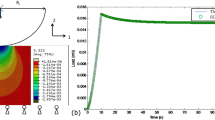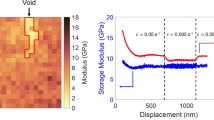Abstract
An experimental study of the elastic and plastic properties of sucrose single crystals, which can be considered to be a model material for both pharmaceutical excipients and explosives, has been carried out using nanoindentation. Instrumented indentation was used to characterize the properties of both habit and cleavage planes on the (100) and (001) orientations; the elastic modulus on the (100) is 38 GPa, while the modulus on the (001) is 33 GPa. The hardness of sucrose is approximately 1.5 GPa. Nanoindentation enables assessment of the onset of plastic deformation on cleaved surfaces, and a maximum shear stress of 1 GPa can be supported prior to plastic deformation. The deformation in this material is crystallographically dependent, with pileup around residual indentation impressions showing evidence of preferential slip system activity.








Similar content being viewed by others
References
J.E. Field, M.M. Chaudhri, G.M. Swallowe S.J.P. Palmer: Report No. Office of Naval Research Interim Report, DAJA37-81-C0081 1981
D.B. Sheen, J.N. Sherwood, H.G. Gallagher, A.H. Littlejohn A. Pearson: Report No. Office of Naval Research Final Report N00014-87-J-1173 1993
T. Kobayashi S. Isoda: Lattice images and molecular images of organic materials. J. Mater. Chem. 3, 1 1993
J.M. Thomas J.O. Williams: Dislocations and the reactivity of organic solids. Prog. Solid State Chem. 6, 119 1971
M.P. Mullarney, B.C. Hancock, G.T. Carlson, D.D. Ladipo B.A. Langdon: The powder flow and compact mechanical properties of sucrose and three high-intensity sweeteners in chewable tablets. Int. J. Pharm. 257, 227 2003
D.E. Hooks K.J. Ramos: Initiation mechanisms in Single Crystal Explosives: Dislocations, Elastic Limits, and Initiation Thresholds 13th International Detonation Symposium, Norfolk, VA 2006 455
R.W. Armstrong: Dislocation-assisted initiation of energetic materials. Central Eur. J. Energ. Mater. 2, 55 2005
R.W. Armstrong, C.S. Coffey W.L. Elban: Adiabatic heating at a dislocation pile-up avalanche. Acta Metall. 30, 2111 1982
S.M. Walley, J.E. Field M.W. Greenaway: Crystal sensitivities of energetic materials. Mater. Sci. Technol. 22, 402 2006
W.C. Duncan-Hewitt G.C. Weatherly: Evaluating the hardness, Young’s modulus and fracture toughness of some pharmaceutical crystals using microindentation techniques. J. Mater. Sci. Lett. 8, 1350 1989
P.J. Halfpenny, K.J. Roberts J.N. Sherwood: Dislocations in energetic materials; Part 3. Etching and microhardness studies of pentaerythritol tetramitrate and cyclotrimethylenetrintitramine. J. Mater. Sci. 19, 1629 1984
X. Liao T.S. Wiedmann: Characterization of pharmaceutical solids by scanning-probe microscopy. J. Pharm. Sci. 93, 2250 2004
X. Liao T.S. Wiedmann: Measurement of process-dependent material properties of pharmaceutical solids by nanoindentation. J. Pharm. Sci. 94, 79 2004
W.C. Duncan-Hewitt, D.L. Mount A. Yu: Hardness anisotropy of acetaminophen crystals. Pharm. Res. 11, 616 1994
S. Finnie, K.V.R. Prasad, D.B. Sheen J.N. Sherwood: Microhardness and dislocation identification studies on paracetamol single crystals. Pharm. Res. 18, 674 2001
C.A. Brookes, J.B. O’Neill B.A.W. Redfern: Anisotropy in the hardness of single crystals. Proc. R. Soc. London A 332, 73 1971
F.W. Daniels C.G. Dunn: The effect of orientation on knoop hardness of single crystals of zinc and silicon ferrite. Trans. ASM 41, 419 1949
S. Amelinckx: The direct observation of dislocation nets in rock salt single crystals. Philos. Mag. 1, 269 1956
Y. Gaillard, C. Tromas J. Woirgard: Study of the dislocation structure involved in a nanoindentation test by atomic force microscopy and controlled chemical etching. Acta Mater. 51, 1059 2003
Y. Gaillard, C. Tromas J. Woirgard: Quantitative analysis of dislocation pile-ups nucleated during nanoindentation in MgO. Acta Mater. 54, 1409 2006
J. Sharma, C.S. Coffey, R.W. Armstrong, W.L. Elban S.M. Hoover: Sub-molecular fracture steps in shock-shattered RDX crystals and follow-on nano-indentation evaluation of early stage plasticity in Shock Compression of Condensed Matter, edited by M.D. Furnish, N.N. Thadhani, and Y. Horie (American Institute of Physics, 2001) 837
C.A. Beevers, T.R.R. McDonald, J.H. Robertson F. Stern: The crystal structure of sucrose. Acta Crystallogr. 5, 689 1952
G.M. Brown H. Levy: Further refinement of the structure of sucrose based on neutron-diffraction data. Acta Crystallogr. B29, 790 1973
W.C. Duncan-Hewitt G.C. Weatherly: Modeling the uniaxial compaction of pharmaceutical powders using the mechanical properties of single crystals. II: Brittle materials. J. Pharm. Sci. 79, 273 1990
J.C.F. Millett N.K. Bourne: The shock Hugoniot of a plastic bonded explosive and inert stimulants. J. Phys. D: Appl. Phys. 37, 2613 2004
S.A. Sheffield, R.L. Gustavsen R.R. Alcon: Porous HMX initiation studies—sugar as an inert stimulant in Shock Compression of Condensed Matter, edited by S.C. Schmidt, D.P. Dandekar, and J.W. Forbes American Institute of Physics, Woodbury, NY 1997 575
S.N. Heavens J.E. Field: The ignition of a thin layer of explosives by impact. Proc. R. Soc. London A 338, 77 1974
J.J. Dick J.P. Ritchie: Molecular mechanics modeling of shear and the crystal orientation dependence of the elastic precursor shock strength in pentaerythritol tetranitrate. J. Appl. Phys. 76, 2726 1994
Z.A. Dreger, Y.A. Gruzdkov, Y.M. Gupta J.J. Dick: Shock wave induced decomposition chemistry of pentaerythritol tetranitrate single crystals: Time-resolved emission spectroscopy. J. Phys. Chem. B 106, 247 2002
D.F. Bahr, D.E. Kramer W.W. Gerberich: Non-linear deformation mechanism during nanoindentation. Acta Mater. 46, 3605 1998
W.C. Oliver G.M. Pharr: An improved technique for determining hardness and elastic modulus using load and displacement sensing indentation experiments. J. Mater. Res. 7, 1564 1992
K.L. Johnson: Contact Mechanics Cambridge University Press, New York 1985 93
S.A.S. Asif J.B. Pethica: Nanoindentation creep of single-crystal tungsten and gallium arsenide. Philos. Mag. A 76, 1105 1997
A.B. Mann J.B. Pethica: The role of atomic size asperities in the mechanical deformation of nanocontacts. Appl. Phys. Lett. 69, 907 1996
C.A. Schuh, J.K. Mason A.C. Lund: Quantitative insight into dislocation nucleation from high-temperature nanoindentation experiments. Nat. Mater. 4, 617 2005
D.F. Bahr G. Vasquez: Effect of solid solution impurities on dislocation nucleation during nanoindentation. J. Mater. Res. 20, 1947 2005
K.A. Nibur, D.F. Bahr B.P. Somerday: Hydrogen effects on dislocation activity in austenitic stainless steel. Acta Mater. 54, 2677 2006
W. Connick F.G.J. May: Dislocation etching of cyclotrimethylene trinitramine crystals. J. Cryst. Growth 5, 65 1969
H.G. Gallager, P.J. Halfpenny J.C. Miller: Dislocation slip systems in pentaerythritol tetranitrate (PETN) and cyclotrimethylene trinitramine (RDX). Philos. Trans. R. Soc. London Ser. A 339, 293 1992
P.J. Halfpenny, K.J. Roberts J.N. Sherwood: Dislocations in energetic materials; Dislocation characterization and post-growth motion in single crystals of cyclotrimethylene trinitramine. Philos. Mag. A 53, 531 1986
D.F. Bahr W.W. Gerberich: Plastic zone and pileup around large indentations. Metall. Mater. Trans. A 27A, 3793 1996
K.A. Nibur D.F. Bahr: Identifying slip systems around indentations in FCC metals. Scripta Mater. 49, 1055 2003
N.A. Stelmashenko, M.G. Walls, L.M. Brown Y.V. Milman: Microindentation on W and Mo oriented single crystals: An STM study. Acta Metall. Mater. 41, 2855 1993
W.C. Duncan-Hewitt G.C. Weatherly: Evaluating the fracture toughness of sucrose crystals using microindentation techniques. Pharm. Res. 5, 373 1989
W.C. Duncan-Hewitt: The use of microindentation techniques to assess the ability of pharmaceutical crystals to form strong compacts. Ph.D. Thesis, University of Toronto, Toronto, Canada 1988
T.F. Page, W.C. Oliver C.J. McHargue: The deformation behavior of ceramic crystals subjected to very low load (nano)indentation. J. Mater. Res. 7, 450 1992
D. Tabor: The Hardness of Metals Oxford University Press, Oxford, England 1951
A.J. Bushby D.J. Dunstan: Plasticity size effects in nanoindentation. J. Mater. Res. 19, 137 2004
J.B. Swadner, B. Taljat G.M. Pharr: Measurement of residual stress by load and depth-sensing indentation with spherical indenters. J. Mater. Res. 16, 2091 2001
J.M. Thomas J.O. Williams: Lattice imperfections in organic solids. Faraday Soc. Trans. 63, 1922 1967
P.R. Perrier S.R. Byrn: Influence of crystal packing on the solid-state desolvation of purine and pyrimidine hydrates: Loss of water of crystallization from thymine monohydrate, cytosine monohydrate, 5-nittrouracil monohydrate, and 2′-Deoxyadenosine Monohydrate. J. Org. Chem. 47, 4671 1982
ACKNOWLEDGMENTS
The authors wish to thank Los Alamos National Laboratories for financial support of this work, and Dr. Daniel E. Hooks and Dr. Stephen A. Sheffield for helpful discussions regarding molecular organics. The contract was supported by the National Nuclear Security Administration Science Campaign Two.
Author information
Authors and Affiliations
Corresponding author
Rights and permissions
About this article
Cite this article
Ramos, K., Bahr, D. Mechanical behavior assessment of sucrose using nanoindentation. Journal of Materials Research 22, 2037–2045 (2007). https://doi.org/10.1557/jmr.2007.0249
Received:
Accepted:
Published:
Issue Date:
DOI: https://doi.org/10.1557/jmr.2007.0249




